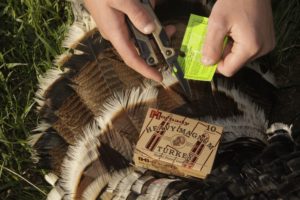Turn the tables for a few weeks this spring and focus on turkeys, but if a coyote comes into range while you're throwing calls at gobblers then smack the songdog, too. (Photo: Mark Kayser)
Hunters are switching up their game as spring spreads across North America. The distant gobble of a tom turkey signals a time to put aside the coyote-getting centerfire and pick up a scattergun for the chance at a turkey dinner.
Most of you target multiple species throughout the year. It’s no different than heading to deer camp in November. Nevertheless, even while on a deer stand waiting for a rutting buck to make a mistake you never overlook a gift coyote if it trots down a deer trail.
The same principle should apply to turkey season. Be ready, coyotes have invaded environments coast to coast and your turkey calls could attract a slinking 'yote looking for a drumstick.
If you want to continue the coyote caper as you pursue a Butterball, you can up the odds. First, consider shotgun-hammering loads that will not only down a nosy tom, but also put the hurt on a coyote at close range. Companies like Hornady design shotgun-walloping loads for just this purpose.
Next, don’t drastically change your turkey tactics. Instead, tweak them to ensure that if a coyote does show curiosity to your setup you’ll be able to tip over another fawn eater. Here are a few things to keep in mind for the possibility of a turkey and coyote combo.
Wind is an Equalizer
Wind is big equalizer when it comes to hunting coyotes. You may have the 400-yard advantage with an accurate predator rifle, but any cloaking terrain features can allow a coyote to slip behind enemy lines and get your scent. Religiously living the scent-free lifestyle with products such as Wildlife Research Center’s Scent Killer help, but you have to play the wind for all-around successful results.
That’s where many turkey hunters fail if hoping to combo up on coyotes. Turkeys have little, if any sense of smell. It’s almost like a hunting vacation to forget about your scent direction and just hunt. You can’t do that if you hope to bag a coyote during your hunt.
At each turkey setup consider the current wind direction. If you’re setting up a ground blind beforehand, do the research and set it up to take advantage of prevailing winds. Hunting apps, like ScoutLook Weather, even include wind dispersion graphics that detail your scent dispersion via a ScentCone wind map. That’s good stuff when you need to know where your scent will blow.
Funnel Setups
Knowing the wind is a starting point, but you also should look for setup sites that force coyotes out in front of you. Preferably they should have a shooting lane or two for the best coverage.
Think of having the wind in your face and obstacles behind you. This could include any obstacle such as a river, a steep bank, a woven wire fence or even vertical hillside.
Terrain or hindrances such as these force a coyote to forgo the wind and tiptoe in front of your shooting position. It also forces turkeys to do the same so it is a win-win.
Excitement Matters
How you call to a turkey often depends on the gobbler’s response. If the turkey appears to enjoy your teasing you can ramp it up. Of course some turkeys prefer the subtle approach. When it comes to piquing the interest of a coyote within earshot the more excited the tone the better your odds of a coyote appearing.
At this time of the year acquiring a meal is top priority. Mom is busy feeding youngsters and dad oftentimes is left to the food gathering chore. A coyote hearing demanding yelps, fighting purrs and cutting sounds likely hears the sounds from farther away. Plus, these excited tones mean the turkeys may be too busy procreating to be on the lookout for Wile E.
Decoy realism
All decoys aren’t created equal. Those old foam decoys of yesteryear don’t cut it today when you want to fool a tom or a coyote. The best you can employ are mounted turkeys including those from Hazel Creek Decoys. They’re costly, but very, very effective.
If you’re on the hunt for new decoys, shop for realistic decoys like those from Avian-X, Primos and Avery, to name a few. Visit your local Cabela’s and compare models and feather realism. If it looks real to you the turkeys and coyotes will love it.
Finally, consider adding movement to your decoy. String movement is affordable, easy and effective. Whether you opt for a heavy monofilament fishing line or high tensile string, you can secure one end to the decoy and unravel a length back to your ambush site. If a turkey or a coyote holds up, tug on the line to make the decoy swivel.
There’s no reason to skip turkey season for another coyote. Combine the two. It’s a great spring outing and turkeys definitely eat better than a coyote.
More top picks from Predator Xtreme:
How to scout in summer for coyotes
3 tips to hunt coyotes the simplest way possible
Coyote 101: Understanding how songdogs rear pups
Wild hogs: A must-hunt species







